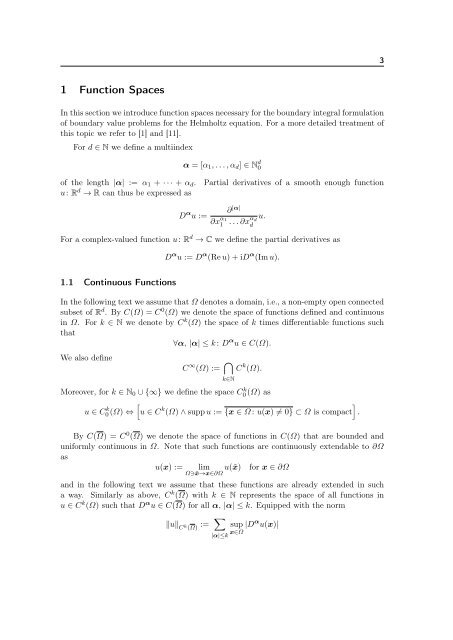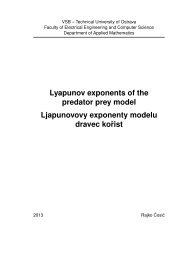The Boundary Element Method for the Helmholtz Equation ... - FEI VÅ B
The Boundary Element Method for the Helmholtz Equation ... - FEI VÅ B
The Boundary Element Method for the Helmholtz Equation ... - FEI VÅ B
Create successful ePaper yourself
Turn your PDF publications into a flip-book with our unique Google optimized e-Paper software.
31 Function SpacesIn this section we introduce function spaces necessary <strong>for</strong> <strong>the</strong> boundary integral <strong>for</strong>mulationof boundary value problems <strong>for</strong> <strong>the</strong> <strong>Helmholtz</strong> equation. For a more detailed treatment ofthis topic we refer to [1] and [11].For d ∈ N we define a multiindexα = [α 1 , . . . , α d ] ∈ N d 0of <strong>the</strong> length |α| := α 1 + · · · + α d .u: R d → R can thus be expressed asPartial derivatives of a smooth enough functionD α u :=∂ |α|∂x α 11 . . . u.∂xα ddFor a complex-valued function u: R d → C we define <strong>the</strong> partial derivatives asD α u := D α (Re u) + iD α (Im u).1.1 Continuous FunctionsIn <strong>the</strong> following text we assume that Ω denotes a domain, i.e., a non-empty open connectedsubset of R d . By C(Ω) = C 0 (Ω) we denote <strong>the</strong> space of functions defined and continuousin Ω. For k ∈ N we denote by C k (Ω) <strong>the</strong> space of k times differentiable functions suchthat∀α, |α| ≤ k : D α u ∈ C(Ω).We also defineC ∞ (Ω) := k∈NC k (Ω).Moreover, <strong>for</strong> k ∈ N 0 ∪ {∞} we define <strong>the</strong> space C0 k (Ω) asu ∈ C0 k (Ω) ⇔ u ∈ C k (Ω) ∧ supp u := {x ∈ Ω : u(x) ≠ 0} ⊂ Ω is compact .By C(Ω) = C 0 (Ω) we denote <strong>the</strong> space of functions in C(Ω) that are bounded anduni<strong>for</strong>mly continuous in Ω. Note that such functions are continuously extendable to ∂Ωasu(x) :=lim u(˜x)Ω∋˜x→x∈∂Ω<strong>for</strong> x ∈ ∂Ωand in <strong>the</strong> following text we assume that <strong>the</strong>se functions are already extended in sucha way. Similarly as above, C k (Ω) with k ∈ N represents <strong>the</strong> space of all functions inu ∈ C k (Ω) such that D α u ∈ C(Ω) <strong>for</strong> all α, |α| ≤ k. Equipped with <strong>the</strong> norm∥u∥ C k (Ω) := sup |D α u(x)|x∈Ω|α|≤k









